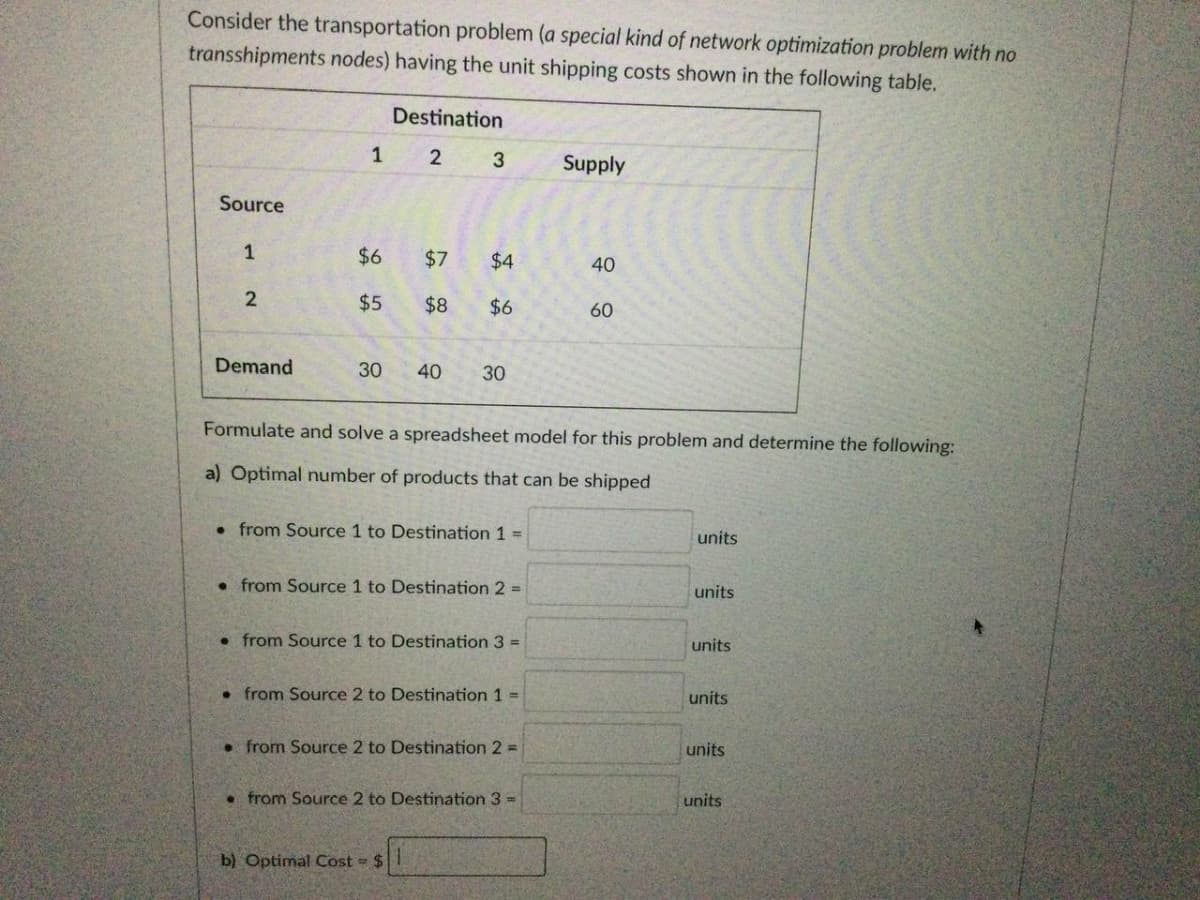Consider the transportation problem (a special kind of network optimization problem with no transshipments nodes) having the unit shipping costs shown in the following table. Destination 1 2 3 Supply Source 1 $6 $7 $4 40 $5 $8 $6 60 Demand 30 40 30 Formulate and solve a spreadsheet model for this problem and determine the following: a) Optimal number of products that can be shipped • from Source 1 to Destination 1 = units • from Source 1 to Destination 2 = units • from Source 1 to Destination 3 = units • from Source 2 to Destination 1 = units • from Source 2 to Destination 2 = units %! • from Source 2 to Destination 3 units %3D b) Optimal Cost = $ 2.
Consider the transportation problem (a special kind of network optimization problem with no transshipments nodes) having the unit shipping costs shown in the following table. Destination 1 2 3 Supply Source 1 $6 $7 $4 40 $5 $8 $6 60 Demand 30 40 30 Formulate and solve a spreadsheet model for this problem and determine the following: a) Optimal number of products that can be shipped • from Source 1 to Destination 1 = units • from Source 1 to Destination 2 = units • from Source 1 to Destination 3 = units • from Source 2 to Destination 1 = units • from Source 2 to Destination 2 = units %! • from Source 2 to Destination 3 units %3D b) Optimal Cost = $ 2.
Practical Management Science
6th Edition
ISBN:9781337406659
Author:WINSTON, Wayne L.
Publisher:WINSTON, Wayne L.
Chapter5: Network Models
Section: Chapter Questions
Problem 47P
Related questions
Question
Show your solution and provide a brief description on how you arrive with the answer. Capture your answer well.

Transcribed Image Text:Consider the transportation problem (a special kind of network optimization problem with no
transshipments nodes) having the unit shipping costs shown in the following table.
Destination
1 2 3
Supply
Source
1
$6
$7
$4
40
$5
$8
$6
60
Demand
30
40
30
Formulate and solve a spreadsheet model for this problem and determine the following:
a) Optimal number of products that can be shipped
• from Source 1 to Destination 1 =
units
• from Source 1 to Destination 2 =
units
• from Source 1 to Destination 3 =
units
• from Source 2 to Destination 1 =
units
• from Source 2 to Destination 2 D
units
• from Source 2 to Destination 3 =
units
b) Optimal Cost = $
Expert Solution
This question has been solved!
Explore an expertly crafted, step-by-step solution for a thorough understanding of key concepts.
This is a popular solution!
Trending now
This is a popular solution!
Step by step
Solved in 2 steps with 1 images

Knowledge Booster
Learn more about
Need a deep-dive on the concept behind this application? Look no further. Learn more about this topic, operations-management and related others by exploring similar questions and additional content below.Recommended textbooks for you

Practical Management Science
Operations Management
ISBN:
9781337406659
Author:
WINSTON, Wayne L.
Publisher:
Cengage,

Practical Management Science
Operations Management
ISBN:
9781337406659
Author:
WINSTON, Wayne L.
Publisher:
Cengage,